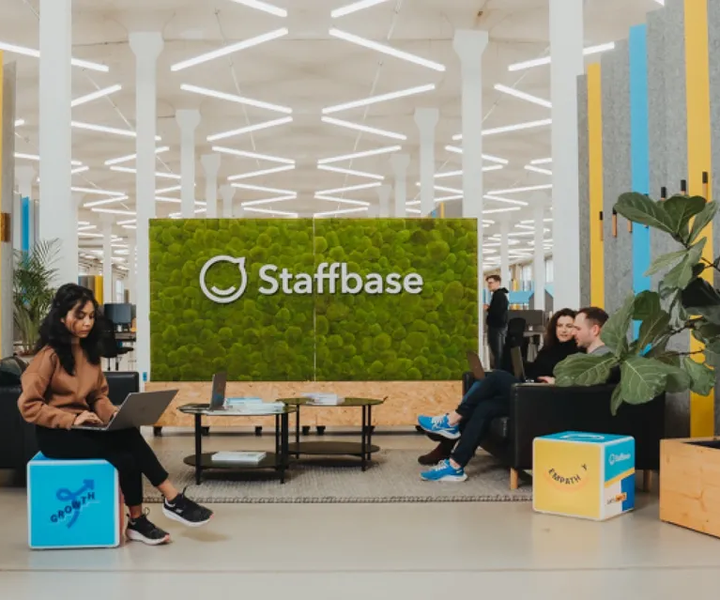Employee Communication Apps: 10 Benefits of a Mobile Comms Platform

Are you reading this on your phone? It wouldn’t be surprising. 6.6 billion people reportedly own a smartphone. Smartphone use touches every aspect of our lives. Whether it’s to communicate via voice or text, check the news, share our opinions, do our banking, buy stuff. . . . The list goes on and on, and increasingly it includes the use of employee communication apps at work.
According to a UK study:
60% of employees now use apps for work-related activities.
71% spend more than two hours a week accessing company information on mobile.
70% of employees keep their phones “within eye contact” at work (as reported by CNBC).
Nevertheless, 59% of workers believe their organization has been too slow at delivering apps for the workforce.
Given these conflicting numbers, it’s safe to guess that too many companies mistakenly believe “communicating” with employees via old-school intranet, email, or collaborative platforms is enough. Clearly, however, it isn’t.
Instead, employees are frustrated – especially the increasing number who work remotely in the wake of the coronavirus crisis. Why? Because they can’t interact and get work-related information from the device they use for everything else in their lives.
But that’s where employee communication apps enter the picture.
What are employee communication apps?
 An employee handbook is just one way to create culture with a mobile comms app.
An employee handbook is just one way to create culture with a mobile comms app.
Employee communication apps can help to build a stimulating, dialogue-driven environment that benefits everyone, from remote or frontline workers to C-suite executives.
Apps can flatten organizational hierarchies and create natural opportunities for workers to share the positive (and negative) aspects of their culture. And they ideally generate a cycle of meaningful, motivating conversations and actionable feedback.
Such consistent, ongoing, multidirectional communication that can reach all employees is the best way to establish a positive workplace culture.
2. Employee Communication Apps Foster Engagement
First the good news: the global percentage of “engaged” workers involved in, enthusiastic about, and committed to their work and workplace is at its all-time high.
The bad news is that that “high” is a mere 23%.
Nearly six out of ten employees are “quietly quitting.” They may be physically present or logged into their computers, but they lack connection to their work and workplace and they only do the minimum required. And they’ll be out the door in an instant for a slightly better offer.
So, how can employee communication apps help?
 Surveys are a great way to create mobile engagement.
Surveys are a great way to create mobile engagement.
Here’s a good example. Don Wooldridge, Vice President of Culture Development and Education at Florida’s TradeWinds Island Resorts, conducted employee engagement surveys for nearly 20 years.
Twelve months after the company began using an employee app, engagement scores rose by an average of three points in every category. And they’ve been on the rise ever since.
Given his company’s success with the app, Wooldridge is eager to share what he’s learned about creating mobile engagement. The overall positivity at TradeWinds, he explains, is a direct result of stronger connectedness between the company’s employees. “An employee app gives you a bigger and more detailed picture of the company and the people that you work with,” he says.
And it’s those human connections, even more than the work itself, that are at the heart of employee engagement.
3. Communication Apps Encourage Employees to Take Part in the Conversation
Here’s a true story.
A woman read a comment in her employee app about a decision to invite a controversial politician to visit company headquarters. She wrote a comment highlighting her feelings about some of the positions that this individual reportedly supported. And she wrote in a heartfelt way about how these attitudes affected her personally.
Her colleagues responded with supportive messages in the form of “likes” and comments. And the company’s CEO even took it upon himself to explain in greater detail the reasoning behind the decision, as well as his own reservations about it.

The result was that the woman and her fellow employees felt a stronger human connection to one another. The CEO was able to see and respond to the concerns of his staff. The People Experience team learned more about how its people thought about values like workplace diversity. And the company as a whole felt more closely aligned behind its transparent and inclusive culture.
All of this was possible because of an open and honest conversation in an employee communications app.
(And by the way, the company was Staffbase.)
4. Employee Apps Provide a Single Source of Streamlined, Relevant Content
How many channels are you using to communicate at work?
Just today, while sitting at my desk, I’ve received messages via Slack, WhatsApp, email, Facebook Messenger, LinkedIn, and iMessage. A couple were personal and others were work-related, but all of them cost time and focus.
The irony is that many of these communication tools were meant to make people like me more productive. But have they? Especially at work, cutting through the noise in order to hear the important information can be a real challenge.
But isn’t an employee app just one more channel?

The answer is a resounding no! When it comes to making work-related information accessible, it is THE channel, pulling together multiple information silos into a single source of trusted, streamlined, and relevant content.
5. Employee Apps Share Today’s News Today
Printed employee newsletters and corporate newspapers are still widely used internal communication tools. And while their purpose remains 100% valid, their delivery via printed copies should mostly be a thing of the past.
Why? Because news happens now.
We had a printed magazine before, and we asked our employees how they liked it. They said, ‘You know what? We believe no one actually reads it.’”
Stefan Rathausky, Senior Vice President Corporate Communications, RHI Magnesita
 Targeted, relevant news is the heart of an effective employee comms app.
Targeted, relevant news is the heart of an effective employee comms app.
Mobile channels also support comments, likes, and sharing. They make news accessible to all employees everywhere, and immediately (when necessary) via push notifications.
6. You Can Make Employee Email More Effective
Employee email is a great way to share certain kinds of information. But knowing when to use it is the best way to ensure your emails get read. With an employee app to handle more time-sensitive internal communication, your messages are assured to reach everyone immediately. And it means that you can get back to using email to share more general information.
With communication needs changing as quickly as workplace demographics, companies are searching for digital channels that enhance the employee experience, support the employer brand, and are of practical use throughout the employee life cycle — from onboarding to engagement and recognition programs. All the things an advanced employee app was designed to do.
Communication outside of the workplace has long since moved to social media platforms and a diverse array of fast, far-reaching digital channels that are second nature to the young people who make up the majority of today’s workers.
It’s time for internal communication to catch up.
7. Employee Apps Meet the Unique Needs of Today’s Modern Workforce
Millennials and Gen Z now make up the biggest part of the workforce. More than any previous generation, they demand mobile communication, transparency, feedback, and an employee experience that lets them work in new, more productive and flexible ways.
An employee app on an employee’s smartphone is tailor made to meet these needs.

Only 55% of employees worldwide currently grade their organizations highly for effective collaboration across departments and functions. This percentage is tragically low given the fact that Gen Z and millennials crave conversation and frequent feedback more than any previous generation.
Gen Z named ‘co-workers who like to collaborate’ as being the type of worker who would help them do their best work, second only to ‘co-workers who work as hard as they do.’ Companies seeking to be an employer of choice must leverage the collaborative revolution taking place and provide the technology, tools, and processes that facilitate and encourage it.”
Jim Link, Chief Human Resources Officer, Randstad North America
8. Apps Let Organizations Measure Their Comms
You can’t manage what you can’t measure. The analytics features of an employee app will allow you to understand how your employee app is being used.
For example, an administration dashboard might feature two charts: “Active Users” will show how many people have opened the app in recent days. You might then filter down to see active users per hour in order to find out when people use the app most.
Another chart might show the interactions of your engaged users, including people who commented and liked your articles. You can also see which content resonates best with which audience or location, via stats for the most viewed, most commented, and most liked articles.
Some employee communication apps will provide an individual report for every article published. It’s available in the app itself so that you can even check out reactions to your articles when you’re on the go. The report includes the number of views, readers, likes, and comments. If the post uses the “acknowledgment” feature, you’ll even see who’s read the article.
Employee apps can also feature Pulse surveys: short employee polls taken at regular intervals. They’re a great way to get immediate insight into the health of a company and its workforce. Pulse surveys can measure a wide variety of topics and items, including overall engagement or feedback specific to a project.

An employee app provides internal communicators with powerful analytics and data-driven results that show the impact of your internal communication and help you create new content that resonates with your workforce.
 Just some of the measurable benefits an employee app can track.
Just some of the measurable benefits an employee app can track.
9. Employee Communication Apps Can Give Your Intranet a Voice
Desktop intranets are far from being the ideal solution for large organizations looking to create a digital workplace that communicates in the culture-building ways now essential for modern enterprises with dispersed workforces.
With mobile workers making up more than 70% of workers in the US, an employee app that sits alongside a modern intranet is the ultimate way to communicate, connect, align, and engage with your people – no matter where they work.
 An employee comms app that sits alongside a modernt intranet is the ultimate way to communicate, connect, align, and engage with your people.
An employee comms app that sits alongside a modernt intranet is the ultimate way to communicate, connect, align, and engage with your people.
An employee app will provide a smarter and more cost-effective intranet, while still allowing you to benefit from the proven core strengths of popular platforms such as SharePoint.
Ask us how you can use an employee app as your mobile-first intranet.
10. Employee Communication Apps Enhance the Employee Experience
According to a recent study by PricewaterhouseCoopers, “leaders say they’re choosing tech with their people in mind, but employees don’t agree.” When considering how much the digital tools people use in their day-to-day jobs affects the employee experience, it’s a big problem.
And consider this:
While PwC reports that 40% to 45% of employees “prefer face-to-face interactions for tasks like performance reviews . . . and asking questions of their Human Resources (HR) team,” it’s that same amount who “prefer many of these same tasks to be partially or fully digitized – a signal that digital assistance does have a place when it’s seamless and unobtrusive, or where it can enhance people’s work experience.”

Remember the story we told in point #3 of this blog post. It’s a great example of how workplace technology in the form of an employee communications app can have a positive effect on the employee experience.
And while it perfectly demonstrates communication with a human touch, it wouldn’t have been possible without the technological advantage of an employee communication app.
Getting started with an employee communications app
Did you read this whole thing? Right on!
Since you’re clearly interested. . . .
Here are 3 things to do next:
1. Test drive a real employee communications app like Staffbase.
We can write about it, we can talk about it, we can make videos about it, but there’s nothing like seeing it for yourself.
“Oh, now I really get it!” is what we hear most from people who’ve experienced a demo up close and personal for the very first time.
2. Dive into the numbers and build your case.
Here’s proof that mobile internal comms creates big returns for business. Get new insights on the business value of internal comms and learn about real-life examples of companies who have saved money by going mobile.
3. Keep Asking Questions.
Even though you’re well on your way to making a great internal communications decision, you probably still have some questions.
Chances are you’ll find the answers here.










